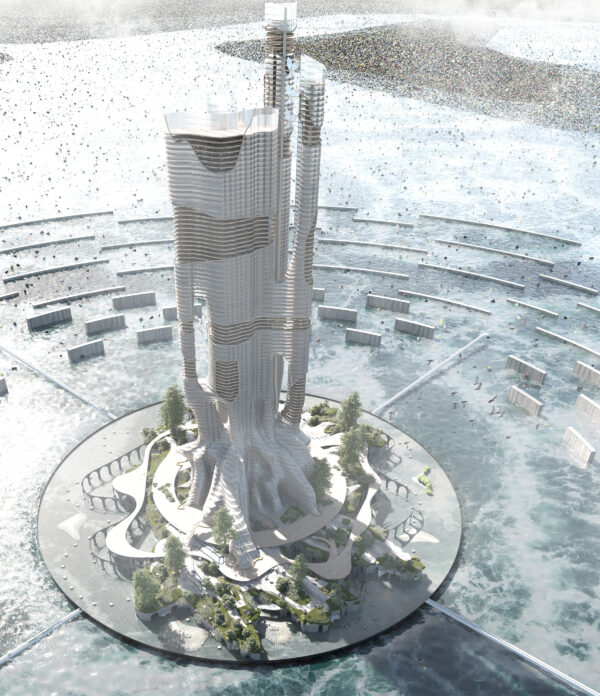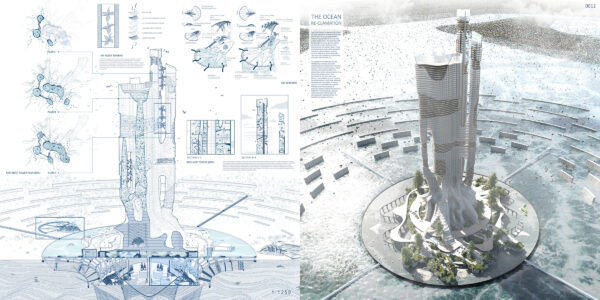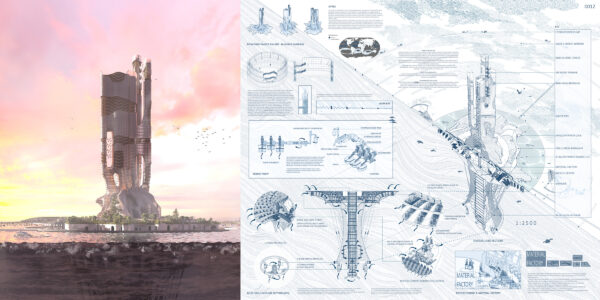Second Place
2023 Skyscraper Competition
Dennis Byun, Harry Tse, Sunjoo Lee
New Zealand
The Great Pacific Garbage Patch and global oil spill have been accumulating in the Pacific Ocean for decades. In recent years, the effects of this environmental disaster have become increasingly visible, with reports of dead marine life washing up ashore with stomachs full of plastic waste.
While many efforts are underway to reduce plastic waste and oil spills, such as recycling programmes and the use of biodegradable plastics, we propose a bold new idea that takes plastic recycling to new heights.
The skyscraper would be a shining example of innovative and sustainable architecture that addresses the problem of plastic pollution while also promoting biodiversity and wildlife conservation. The building’s exterior facade would be made entirely of recycled plastic sourced from ocean waste. But the true innovation of this idea lies in repurposing rubbish into reinforced plastic as a new building material. The once hazardous small plastic bits will be moulded into a solid structure you can no longer consume or entangle, instead inhabit. Thus re-creating a safer environment for sea animals and nature.
The tower is designed to move with the rubbish gyres (garbage patches) to collect and recycle its content. The movement of the gyres is primarily driven by ocean currents and wind patterns, so the organic facade and curved tower will naturally shift with the current if positioned near any major rubbish gyres. All the rubbish is sorted and taken to a material factory to be repurposed in the construction of the tower. The tower works in tandem with time, with the continuous construction of the plastic bird nesting tower and the cleaning of the ocean allowing a new mass breeding of once-endangered marine life.
The outer ring of the lower structure serves as a suction port. The combination of polyester absorption filters and rotating suction filters separate plastic waste, directing it down to the mechanical recycling center. The water separated will be pushed downwards by custom stabilizers functioning as water jet-pack thrusters. The vertical propeller also provides propulsion forces, maintaining uplift forces for the tower to float above water.
Barriers surround the tower to tame the turbulence and allow rubbish to access the filter. It also protects the shallow water marine life inside the tower. A series of hydro pumps are mounted onto the external barrier to converting the kinetic energy from the current into hydraulic energy for other devices.
In addition to its innovative plastic reuse capabilities and design, the skyscraper has large open spaces, balconies trees, and other natural elements that attract birds to inhabit and nest, providing shelter and nutrition in the middle of the great ocean. The structure provides an ideal nesting environment for birds. The combination of a Montezuma Oropendola nest and the Social Weaver provides a sheltered and predator-proof environment that incorporates advanced ventilation and insulation systems within the tower. In between the structure ate Air Pollution Filter turbine uses carbon-based materials to capture a range of contaminants, including volatile organic compounds and other harmful pollutants, cleaning the atmosphere.
The smaller components of this skyscraper are primarily aimed at oil spill problems in the ocean. The Skimmer Mech acts as a sea vacuum cleaner to collect oil for reclamation or disposal whereas the Sorbent Mech spreads eco-flex sponges to absorb oil and later extracted it in the recycling center.
In conclusion, the proposed skyscraper is a visionary project that would showcase the potential of sustainable architecture. The building’s design and functionality would be an essential step towards addressing the problem of plastic & oil pollution and promoting biodiversity and wildlife conservation. It is a bold and innovative proposal that shows what is possible when we combine imagination, innovation, and a commitment to sustainability.

















